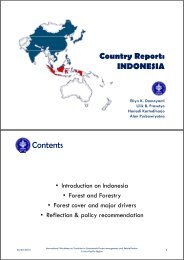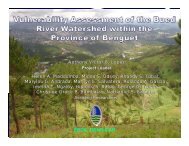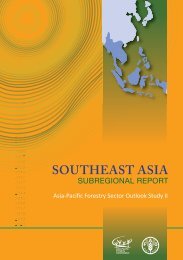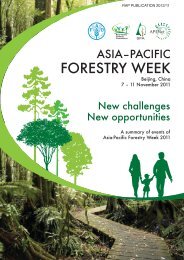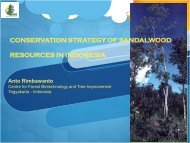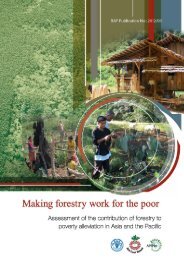Community guidelines for accessing forestry voluntary carbon ... - FAO
Community guidelines for accessing forestry voluntary carbon ... - FAO
Community guidelines for accessing forestry voluntary carbon ... - FAO
You also want an ePaper? Increase the reach of your titles
YUMPU automatically turns print PDFs into web optimized ePapers that Google loves.
Chapter 5: Project implementation: field work<br />
After identifying the baseline strata by visual characteristics and local<br />
knowledge, the project team will need to conduct a baseline inventory<br />
to calculate <strong>carbon</strong> stocks in 10-15 sample plots in each stratum. On<br />
the basis of these samples, the project developers can check if there<br />
is significant variation in <strong>carbon</strong> stock values between the plots within<br />
the same stratum. If so, then that stratum is not useful in the context<br />
of <strong>carbon</strong> stock measurement and the project developer must look <strong>for</strong> a<br />
different basis <strong>for</strong> stratification.<br />
A tool has been developed <strong>for</strong> A/R CDM to help project developers with<br />
the process of checking stratification. It is just as viable <strong>for</strong> <strong>for</strong>estry VCM<br />
projects and can be downloaded from the CDM website. 33 The Good<br />
Practice Guidelines (2003) provided by the Inter-Governmental Panel on<br />
Climate Change (IPCC) 34 also provide good insights into the stratification<br />
processes. Involving local communities in this work is a great opportunity<br />
to train a field team on data collection methods, as demonstrated in the<br />
“Field guide <strong>for</strong> assessing and monitoring reduced <strong>for</strong>est degradation<br />
and <strong>carbon</strong> sequestration by local communities”, available from www.<br />
community<strong>carbon</strong><strong>for</strong>estry.org,<br />
The number of sample plots required <strong>for</strong> accurate monitoring of<br />
<strong>carbon</strong> stock is dependent on the extent and type of <strong>for</strong>est categories.<br />
Permanent sample plots, established <strong>for</strong> such monitoring, must be<br />
of the same size and shape as those used in the pilot survey. Plots<br />
should be generated randomly using a basic outline map of the project<br />
area and strata. A tool has been developed <strong>for</strong> the determination of<br />
the appropriate number of sample plots: see http://cdm.unfccc.int/<br />
methodologies/ARmethodologies/tools/ar-am-tool-03-v2.1.0.pdf<br />
33 http://cdm.unfccc.int/methodologies/ARmethodologies/tools/ar-am-tool-03-<br />
v2.1.0.pdf<br />
34 More details are available within IPCC methodologies, GPG (Good Practice<br />
Guidelines) including Uncertainty In<strong>for</strong>mation and how to use it and Quality<br />
Assurance and Control and CDM tools. UNFCCC also provides methodological tools<br />
<strong>for</strong> calculating number of sample plots.<br />
123




